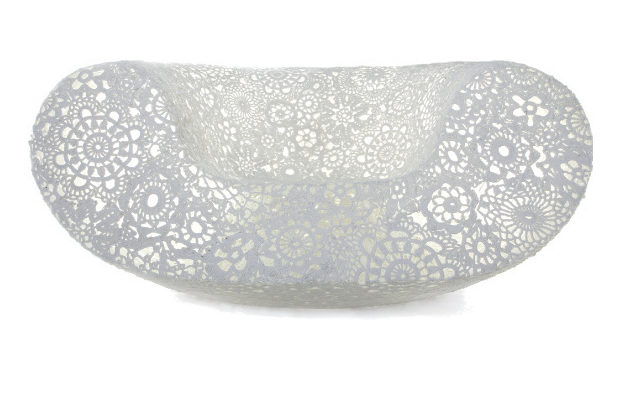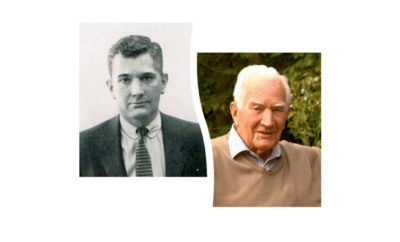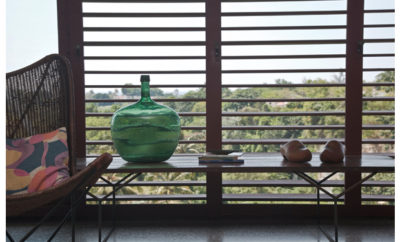
Feature
The High Road

The new gallery is located on the top floor of the museum’s 1983 building by Richard Meier, in the space behind the small square windows.
One of the first galleries in this country devoted exclusively to twenty-first-century design opens at the High Museum this March.
When we first tried to track her down to find out more about the gallery of twenty-first-century design she’s installing at Atlanta’s High Museum of Art, Sarah Schleuning was at the automobile show in Detroit. Wow, we thought, was she looking for a sleek car to include in the gallery? “That would have been fun,” she says, but, no, she was doing research for an exhibition about “concept cars” that she’s planning for 2014. Concept cars are an enticing prospect, but the new gallery is more than enough to give you an idea of what makes Schleuning, who came to the High from the Wolfsonian-FIU Museum less than a year ago, tick.
When it comes to design, she takes the long view. As the Curator of Decorative Arts and Design, she has the care of the museum’s exceptional holdings of American decorative arts from the eighteenth century forward. “With that depth of design, I wanted to explore the idea that while enormous technological and even philosophical advances have revolutionized ideas about such things as furniture and ceramics, it’s been about evolution, too,” she says. “We want visitors to consider what is happening now—to see and engage in the possibilities of the moment—but also to see the similarities and differences with the past.”
Take the four chairs she has grouped near each other in the new gallery, only one of which—Front Design’s Round-back chair from the Sketch Furniture series—much resembles a traditional chair with four legs. And it’s made by rapid prototyping from thermoplastic powder! All the chairs draw from the past in some way: Mathias Bengtsson’s Slice chair speaks to the laminated furniture made by John Henry Belter in the nineteenth century; nendo’s Visible Structures armchair seems descended from Koloman der consideration for acquisition, a lot of people wondered if Schleuning had made it herself. Chuckling, she notes that what was most important was that Wanders’s chair was being appreciated for its link to traditional needlework. “Even a lot of the people who are working in newer materials and with technologically advanced methods are still hand-finishing—it isn’t lost,” she says. “And some are working entirely in traditional mediums, but have taken them to new heights: North Carolina ceramist Mark Hewitt’s That’s What I’m Talking About is a glazed stoneware vase that stands more than four feet tall.
Installed in a light-filled gallery at the top of the High’s Richard Meier building, the objects Schleuning has selected are also intended to spark exploration and discussion of processes and materials. What exactly is rapid prototyping, anyway—and thermoplastic powder? Is the Crochet chair actually weight-bearing? How is that possible? What other materials are represented in these objects, and what does it all mean for the design of everything else—today and tomorrow?
Each piece is given sufficient space to be considered on its own, as well as within the context of the other objects. “You need space just to understand what you’re looking at with Joris Laarman Lab’s Ivy climbing system,” Schleuning says. From a photograph it’s even harder, but, it is, she explains, “simultaneously elegant architectural decor and a functional, adventurous mode of transport!”
Laarman is a designer of particular interest to Schleuning, and so she appreciates that the High, which made the decision to keep its holdings current to the present back in the 1980s (when it acquired Ettore Sottsass’s Carlton room divider), does not insist on an encyclopedic collection. This policy “lets us pick designers we think are interesting—that have ‘something’— and lets us take the journey with them. We would rather buy multiple examples of one person’s work than single pieces by several different designers.” In addition to Ivy, the museum has one of Laarman’s Bone chairs and a Leaf table. And last summer his Digital Matter installation—a robot that repeatedly assembled an eighteenth-century rococo style table from tiny three-dimensional pixels, or voxels — mesmerized viewers. If you missed it, another twenty-first-century creation, YouTube, allows you to watch the installation in action, and to contemplate its ramifications.
American architect and designer Johanna Grawunder is another favorite of Schleuning’s, and the High was the first American museum to collect her work seriously. “We have her Specchio d’Italia mirror, which represents her visionary work in lighting, as well as the Splits bench from her I’m Bringing Sexy Back collection,” Schleuning says, “but I’d like to acquire some of her glasswork too, because, again, the multiplicity of mediums lets you show the flexibility of these designers.” Grawunder is one of the few contemporary American designers represented in the collection, but having worked extensively with Sottsass in Milan she forms a natural bridge between the High’s American holdings and the international nature of design today.
If you’re in Atlanta, a visit to the gallery will surely make you think about design—past, present, and future. Even if you’re not, Schleuning points out, you can download one of her favorite examples of contemporary design right onto your phone—Martin Baas’s Analog Digital Clock. “It’s the ultimate in democratic design—you can have this great piece that’s in a museum and you can have right there on your phone for 99 cents!”

Tejo Remy, one of the earliest members of the Dutch group Droog, designed his first chest of recycled drawers in 1991. In 2008 the High sent out a statewide call for drawers from any type of furniture, and Remy traveled to Atlanta to assemble them into this chest before a live audience. It is called You Can’t Lay Down Your Memory to emphasize his belief in the memories objects hold for their owners.

One of the most recent additions to the collection is the 2006 prototype of Marcel Wanders’s Crochet chair, constructed from individual hand-crocheted rosettes pieced together to form a fabric, then dipped in epoxy resin and hardened over a mold.












